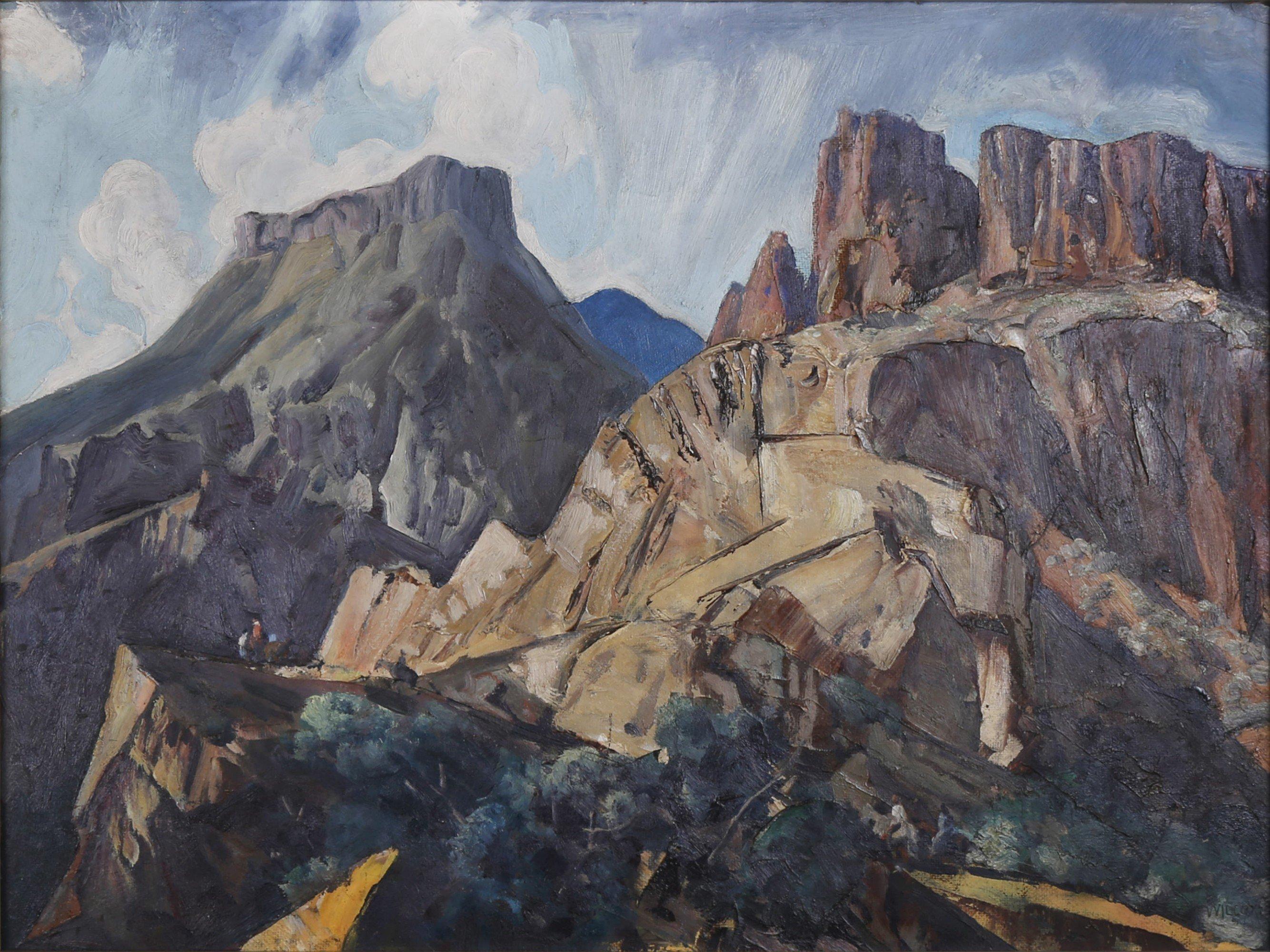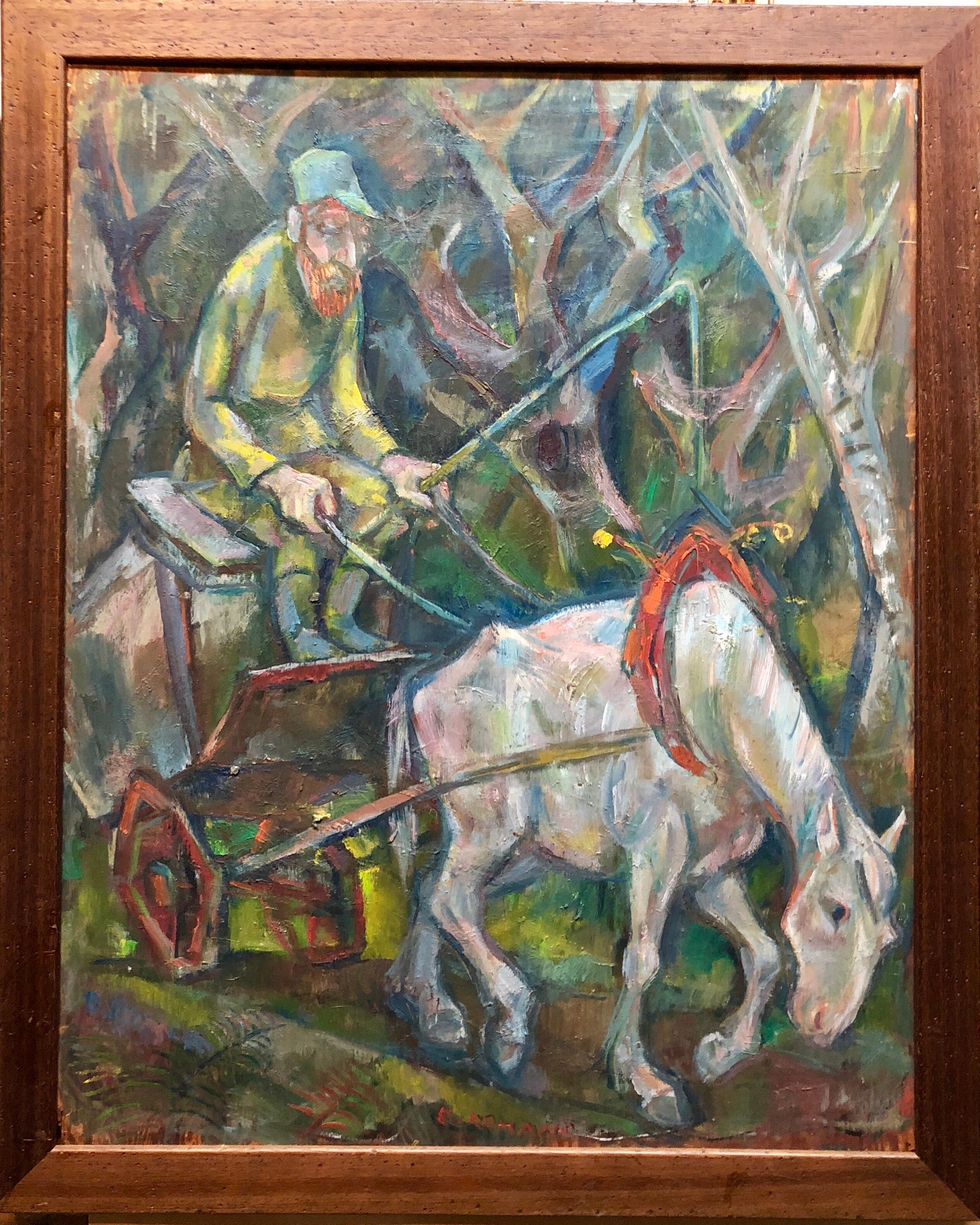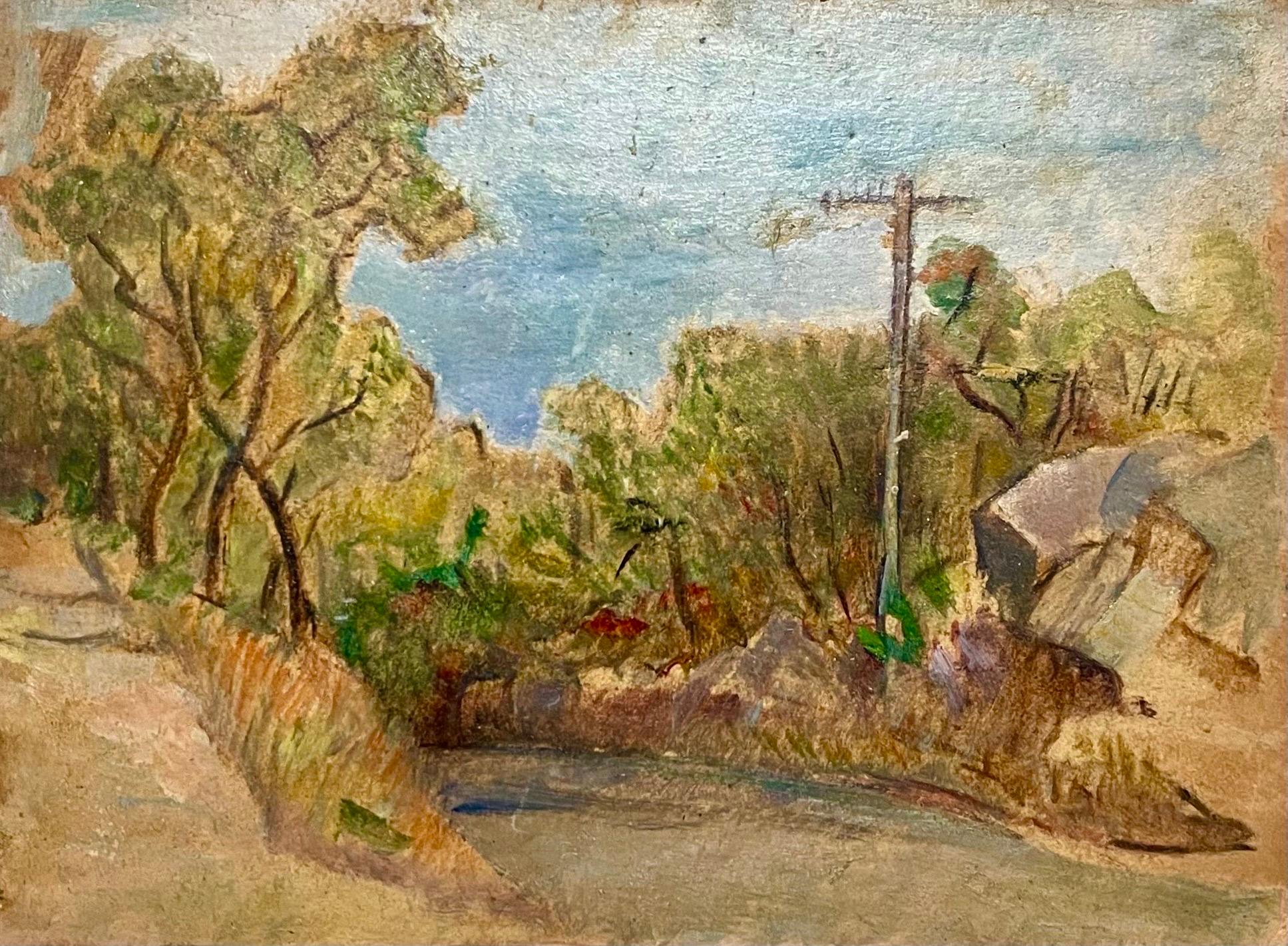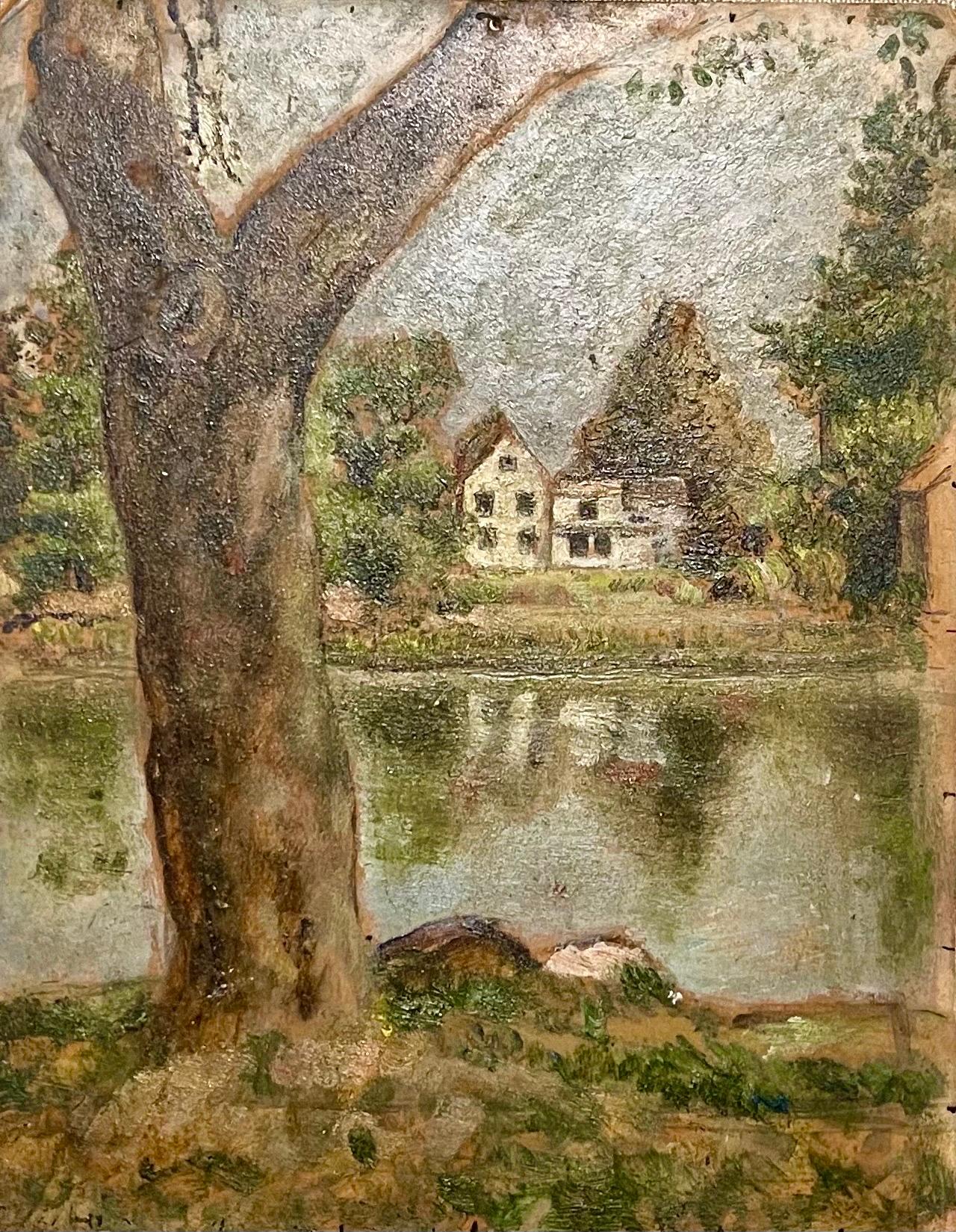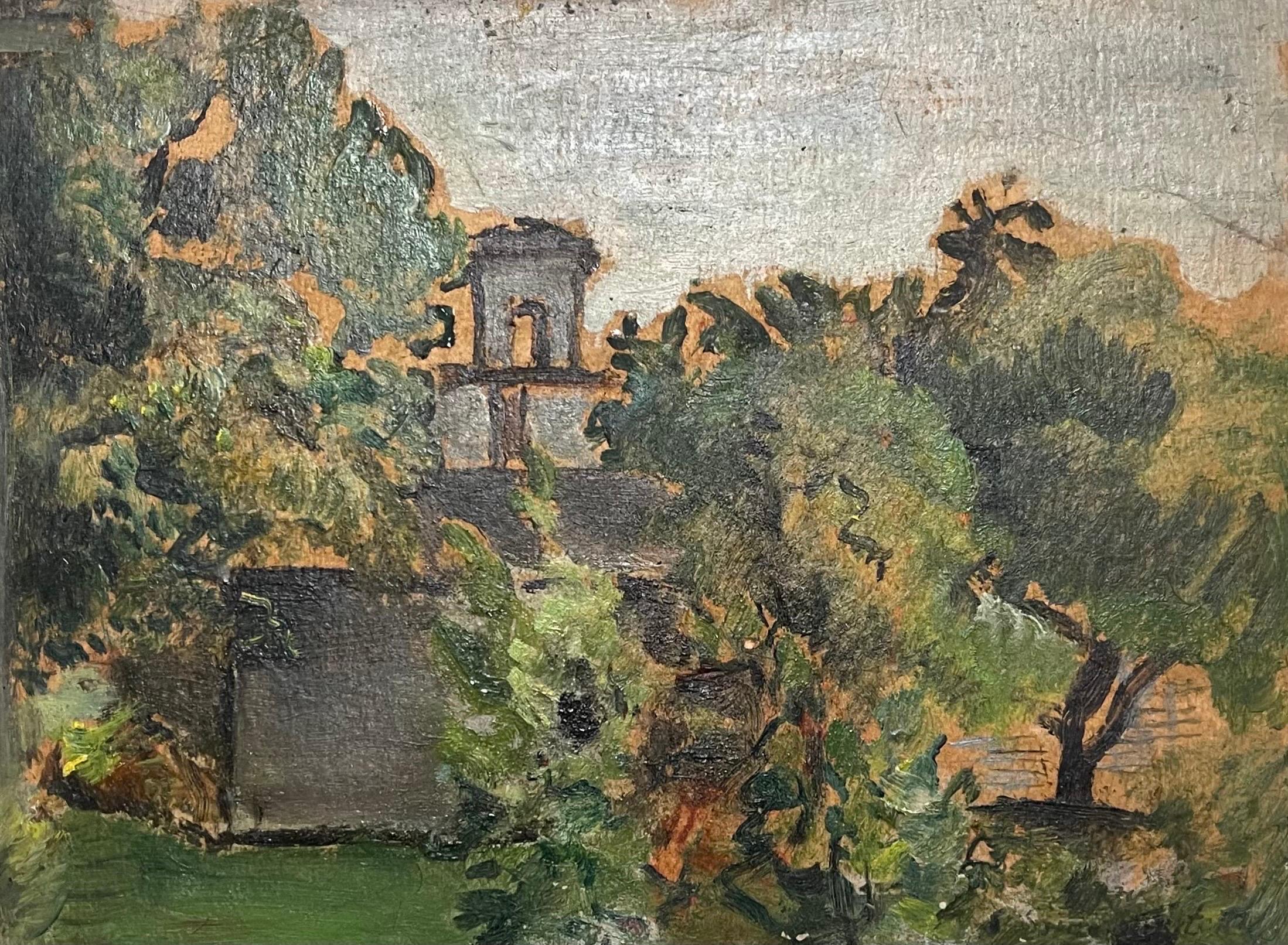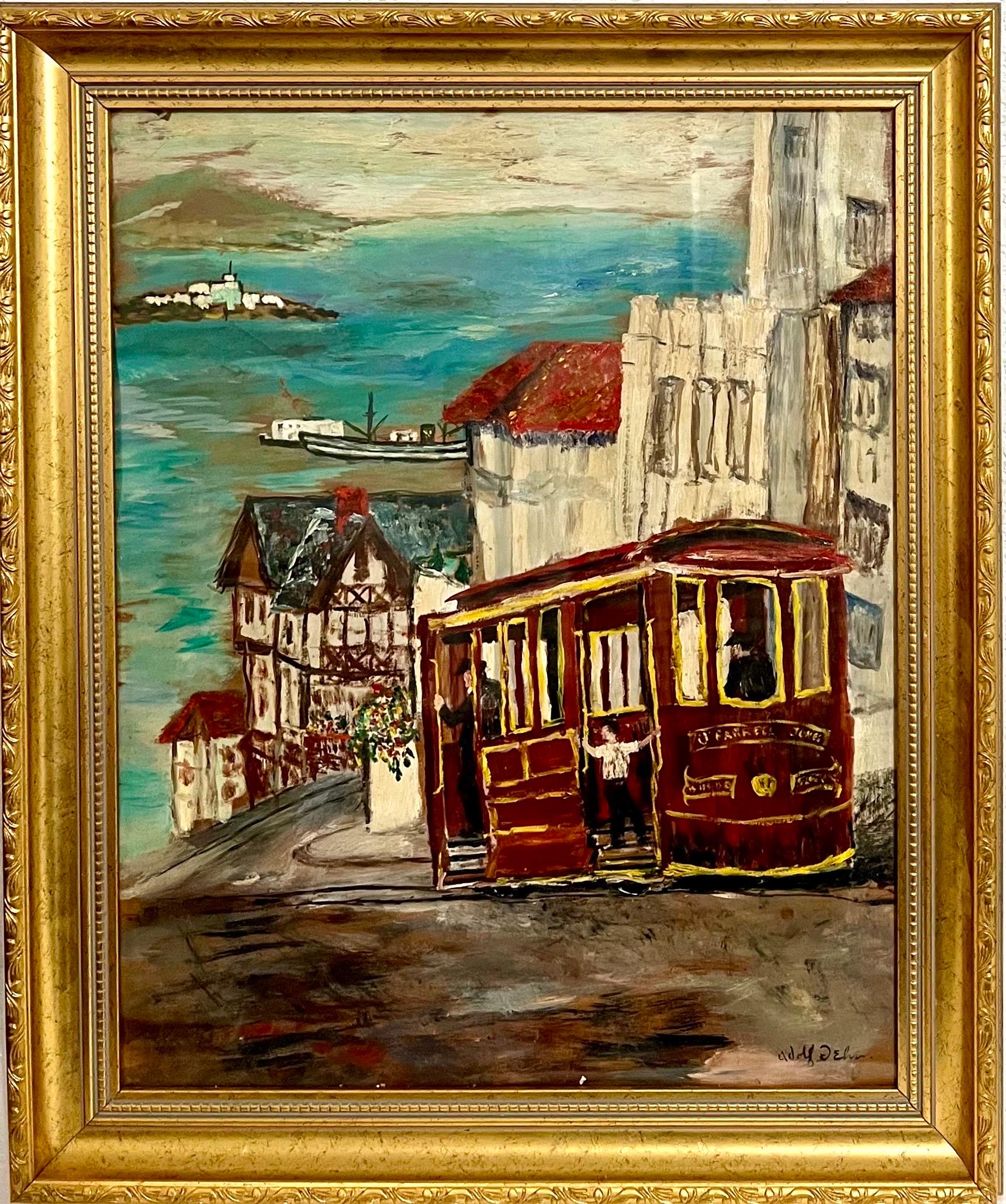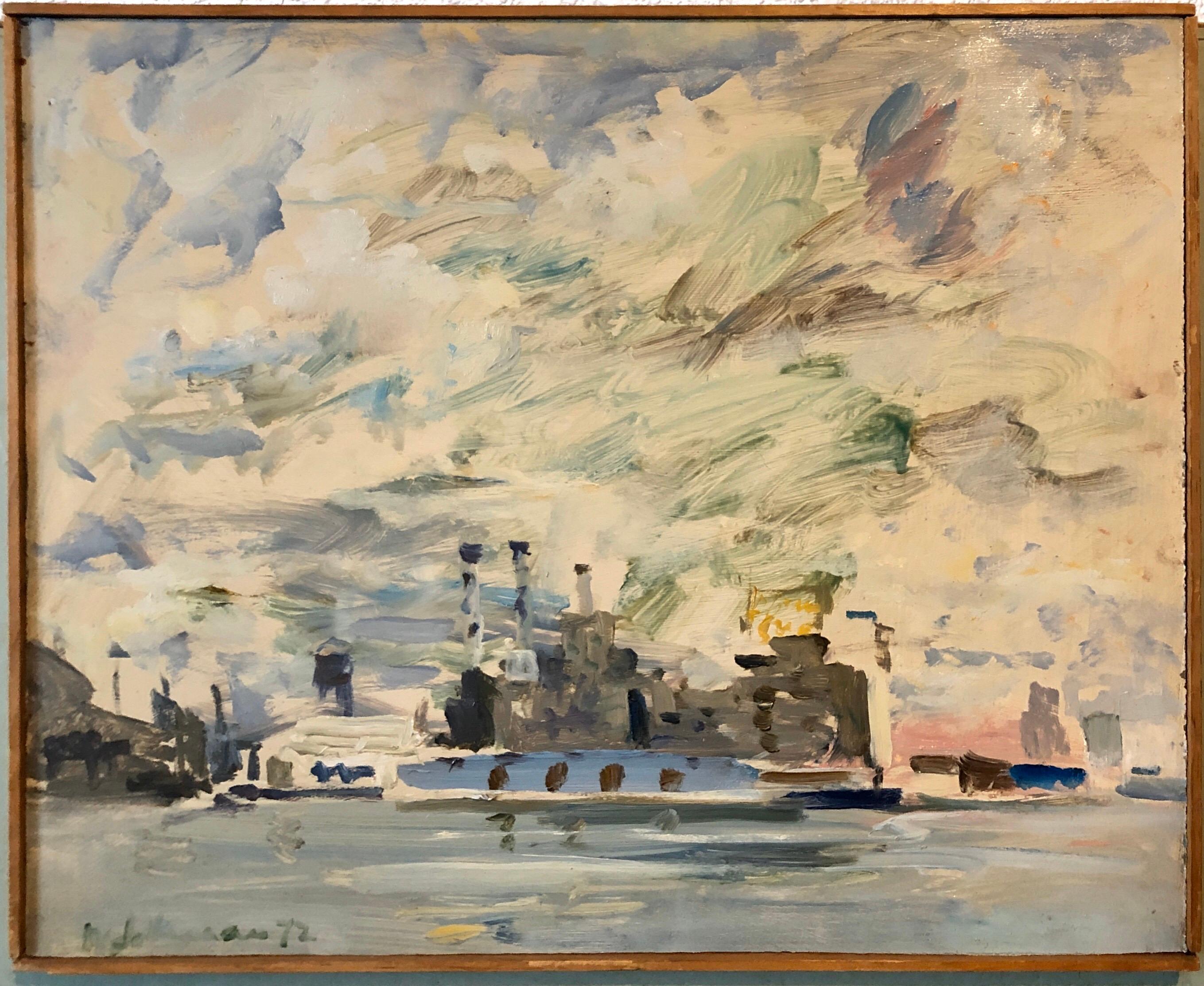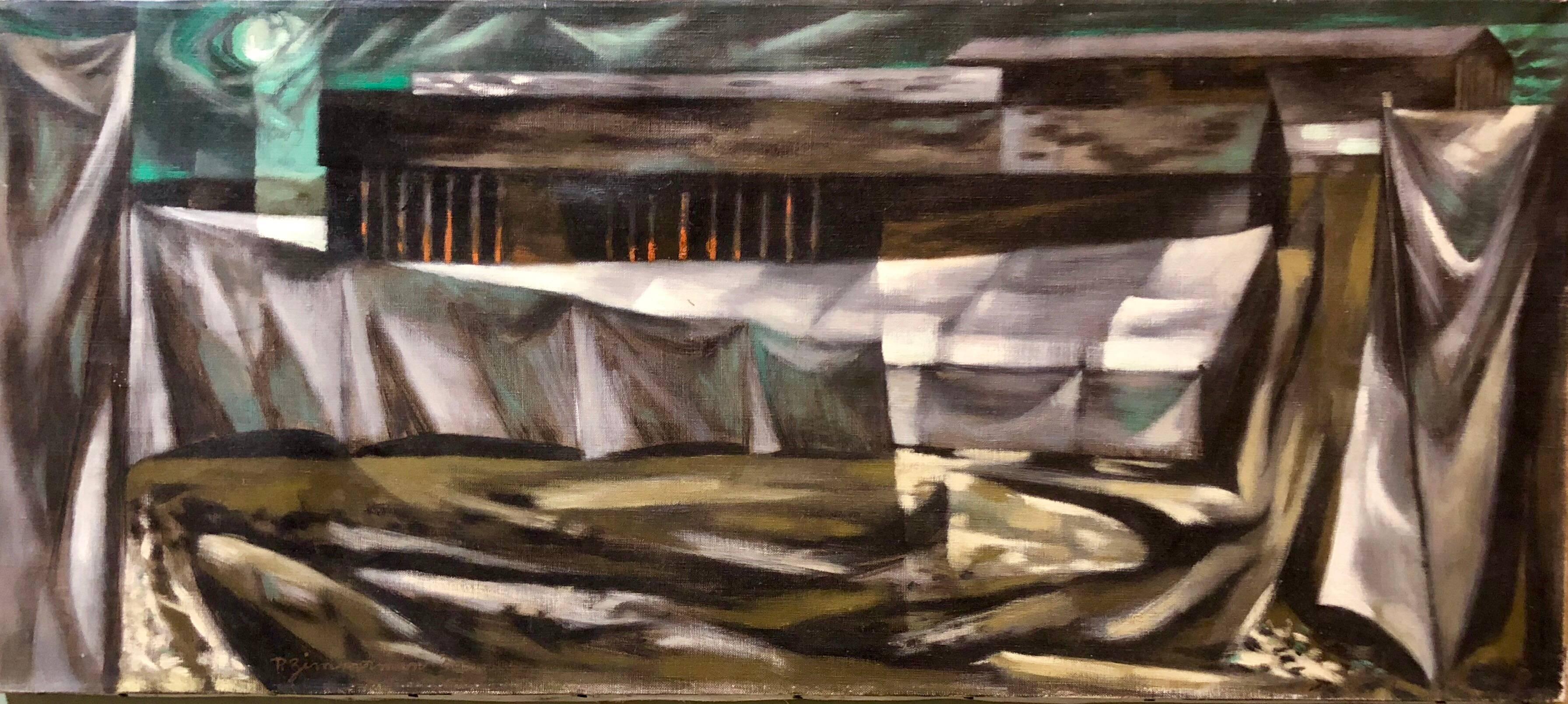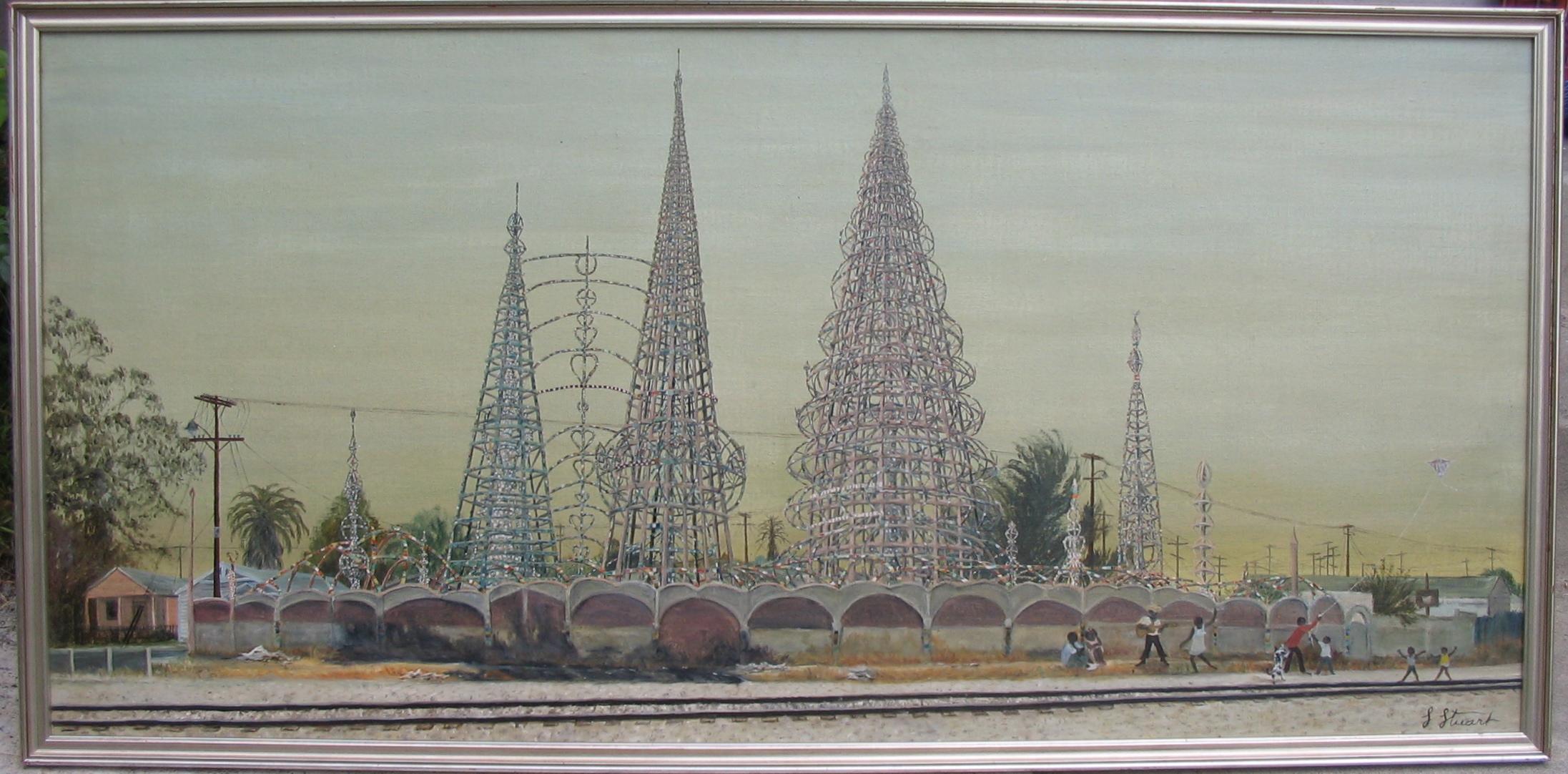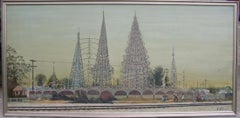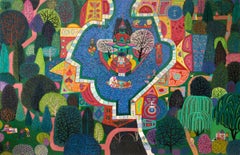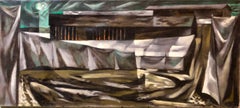
Social Realist Street Scene Modernist Landscape Oil Painting
Want more images or videos?
Request additional images or videos from the seller
1 of 7
Paul ZimmermanSocial Realist Street Scene Modernist Landscape Oil Painting1953
1953
About the Item
- Creator:Paul Zimmerman (American)
- Creation Year:1953
- Dimensions:Height: 16 in (40.64 cm)Width: 36 in (91.44 cm)
- Medium:
- Movement & Style:
- Period:
- Condition:unframed.
- Gallery Location:Surfside, FL
- Reference Number:1stDibs: LU3822541973
About the Seller
4.9
Platinum Seller
These expertly vetted sellers are 1stDibs' most experienced sellers and are rated highest by our customers.
Established in 1995
1stDibs seller since 2014
1,549 sales on 1stDibs
Typical response time: 1 hour
More From This SellerView All
- 1927 Oil Painting Eiffel Tower Paris American Modernist Wpa Artist Morris KantorBy Morris KantorLocated in Surfside, FLMorris Kantor New York (1896 - 1974) Paris from the Ile St. Louis, 1927 (view of Eiffel Tower) Oil painting on canvas Hand Signed lower left. Provenance: Hirshhorn Museum and Sculpture Garden, Smithsonian Institution ( bears label verso) Size: 20 3/4"H x 28 1/8"W (sight), 28.75 "H x 36"W (framed) Morris Kantor (Belarusian: Морыс Кантор) (1896-1974) was a Russian Empire-born American painter based in the New York City area. Born in Minsk on April 15, 1896, Kantor was brought to the United States in 1906 at age 10, in order to join his father who had previously relocated to the states. He made his home in West Nyack, New York for much of his life, and died there in 1974. He produced a prolific and diverse body of work, much of it in the form of paintings, which is distinguished by its stylistic variety over his long career. Perhaps his most widely recognized work is the iconic painting "Baseball At Night", which depicts an early night baseball game played under artificial electric light. Although he is best known for his paintings executed in a realistic manner, over the course of his life he also spent time working in styles such as Cubism and Futurism, and produced a number of abstract or non-figural works. A famous cubist, Futurist, painting of his "Orchestra" brought over 500,000$ at Christie's auction house in 2018 Kantor found employment in the Garment District upon his arrival in New York City, and was not able to begin formal art studies until 1916, when he began courses at the now-defunct Independent School of Art. He studied landscape painting with Homer Boss (1882-1956). In 1928, after returning to New York City from a year in Paris, Kantor developed a style in which he combined Realism with Fantasy, often taking the streets of New York as his subject matter. He did some moody Surrealist Nude paintings and fantasy scenes. In the 1940's he turned towards figural studies. Later in his career, Kantor himself was an instructor at the Cooper Union and also at the Art Students League of New York in the 1940s, and taught many pupils who later became famous artists in their own right, such as Knox Martin, Robert Rauschenberg, Sigmund Abeles and Susan Weil...Category
1920s American Modern Landscape Paintings
MaterialsCanvas, Oil
- 1930 Oil Painting Sea Side Sailboats American Modernist WPA Artist Morris KantorBy Morris KantorLocated in Surfside, FLMorris Kantor, American, 1896-1974 Seaside View, 1930 Hand signed M. Kantor and dated 1930 lower right Oil on canvas 22 1/4 x 19 1/4 inches 24 1/2 x 21 (frame) Morris Kantor (Belarusian: Морыс Кантор) (1896-1974) was a Russian Empire-born American painter based in the New York City area. This is a beautiful boat scene with a river or lake probably on Long Island. Born in Minsk on April 15, 1896, Kantor was brought to the United States in 1906 at age 10, in order to join his father who had previously relocated to the states. He made his home in West Nyack, New York for much of his life, and died there in 1974. He produced a prolific and diverse body of work, much of it in the form of paintings, which is distinguished by its stylistic variety over his long career. Perhaps his most widely recognized work is the iconic painting "Baseball At Night", which depicts an early night baseball game played under artificial electric light. Although he is best known for his paintings executed in a realistic manner, over the course of his life he also spent time working in styles such as Cubism and Futurism, (influenced by the Art Deco movement) and produced a number of abstract or non-figural works. A famous cubist, Futurist, painting of his "Orchestra" brought over 500,000$ at Christie's auction house in 2018. Kantor found employment in the Garment District upon his arrival in New York City, and was not able to begin formal art studies until 1916, when he began courses at the now-defunct Independent School of Art. He studied landscape painting with Homer Boss (1882-1956). In 1928, after returning to New York City from a year in Paris, Kantor developed a style in which he combined Realism with Fantasy, often taking the streets of New York as his subject matter. He did some moody Surrealist Nude paintings and fantasy scenes. In the 1940's he turned towards figural studies. Later in his career, Kantor himself was an instructor at the Cooper Union and also at the Art Students League of New York in the 1940s, and taught many pupils who later became famous artists in their own right, such as Knox Martin, Robert Rauschenberg, Sigmund Abeles and Susan Weil...Category
1930s American Modern Landscape Paintings
MaterialsCanvas, Oil
- Simka Simkhovitch WPA Artist Oil Painting American Modernist Landscape Pond TreeBy Simka SimkhovitchLocated in Surfside, FLSimka Simkhovitch (Russian/American 1893 - 1949) This came with a small grouping from the artist's family, some were hand signed some were not. Thes...Category
1930s American Modern Landscape Paintings
MaterialsOil, Board
- Large Modernist Oil Painting 1940s, Judaica Hasidic Shtetl Wagon Driver WPA EraBy Emanuel Glicenstein RomanoLocated in Surfside, FLGenre: Modern Subject: Landscape with figure of horse, driver and wagon Medium: Oil Surface: wood Board EMANUEL ROMANO Rome, Italy, b. 1897, d. 1984 Emanuel Glicen Romano was born in Rome, September 23, 1897. His father Henryk Glicenstein was a sculptor and was living in Rome with his wife Helena (born Hirszenberg) when Emanuel was born. His father obtained Italian citizenship and adopted the name Enrico. Emanuel was brought up in Italy, Switzerland, Germany, England and Poland. In 1926 Emanuel Glicenstein Romano and his father sailed for New York. They briefly visited Chicago. Romano's sister, Beatrice, and mother only joined them in New York years later. Romano changed his name on his arrival to America and some have erroneously speculated that this was to avoid antisemitic discrimination. In truth, as the son of a highly-regarded artist, Romano changed his name to ensure that any success or recognition he would later attain, would be the result of nothing other than his own merit as an artist, and not on account of his father's fame. In 1936 Romano was worked for the WPA Federal Art Project creating murals. ( there were many jewish artists active with in the WPA period. notably Chaim Gross, Ben Shahn, Isaac and Moses Soyer, Abraham Rattner and many others. During and immediately after World War II, Romano created a series of allegorical works depicting graphic holocaust images that were held closely by the family until after his passing. One of these works is now on permanent display in the Florida Holocaust Museum in St. Petersburg Florida. Emanuel's father died in 1942 in a car accident before they could realize their shared dream of visiting Israel. In 1944 Romano, having completed his degree at the Pennsylvania Academy of Fine Arts and the Art Institute of Chicago, began teaching at the City College of New York. Romano moved to Safed, Israel in 1953 and established an art museum in his father's memory, the Glicenstein Museum. COLLECTIONS Indianapolis Museum of Art Metropolitan Museum of Art Boston Fine Arts Museum Fogg Museum Musée Nacional de France Recently his work has been added to the Florida Holocaust Museum collection. His notable works include his holocaust themed allegorical paintings as well as portraits of Marianne Moore, his father and William Carlos Williams...Category
1930s American Modern Figurative Paintings
MaterialsOil, Board
- Simka Simkhovitch WPA Artist Oil Painting American Modernist Landscape w TowerBy Simka SimkhovitchLocated in Surfside, FLSimka Simkhovitch (Russian/American 1893 - 1949) This came with a small grouping from the artist's family, some were hand signed some were not. Thes...Category
1930s American Modern Landscape Paintings
MaterialsOil, Board
- Simka Simkhovitch WPA Artist Oil Painting Gouache American Modernist PowerlineBy Simka SimkhovitchLocated in Surfside, FLSimka Simkhovitch (Russian/American 1893 - 1949) This came with a small grouping from the artist's family, some were hand signed some were not. These were studies for larger paintings. Simka Simkhovitch (Симха Файбусович Симхович) (aka Simka Faibusovich Simkhovich) (Novozybkov, Russia May 21, 1885 O.S./June 2, 1885 N.S.—Greenwich, Connecticut February 25, 1949) was a Ukrainian-Russian Jewish artist and immigrant to the United States. He painted theater scenery in his early career and then had several showings in galleries in New York City. Winning Works Progress Administration (WPA) commissions in the 1930s, he completed murals for the post offices in Jackson, Mississippi and Beaufort, North Carolina. His works are in the permanent collections of the Dallas Museum of Art, the National Museum of American Art and the Whitney Museum of American Art. Born outside Kyiv (Petrograd Ukraine) into a Jewish family who owned a small department store. During a severe case of measles when he was seven, Simcha Simchovitch sketched the views outside his window and decided to become an artist, over his father's objections. Beginning in 1905, he studied at the Grekov Odessa Art School and upon completion of his studies in 1911 received a recommendation to be admitted to the Imperial Academy of Arts. Though he enrolled to begin classes in architecture, painting, and sculpture at the Imperial Academy, he was dropped from the school roster in December because of the quota on the number of Jewish students and drafted into the army. Simchovitch served as a private in the 175th Infantry Regiment Baturyn [ru] until his demobilization in 1912. Re-enrolling in the Imperial Academy, he audited classes. Simka Simkhovitch exhibited paintings and sculptures in 1918 as part of an exhibition of Jewish artists and in 1919 placed 1st in the competition "The Great Russian Revolution" with a painting called "Russian Revolution" which was hung in the State Museum of Revolution. In 1922, Simkha Simkhovitch exhibited at the International Book Fair in Florence (Italian: Fiera Internazionale del Libro di Firenze). In 1924, Simkhovitch came to the United States to make illustrations for Soviet textbooks and decided to immigrate instead. Initially he supported himself by doing commercial art and a few portrait commissions. In 1927, he was hired to paint a screen for a scene in the play "The Command to Love" by Fritz Gottwald and Rudolph Lothar which was playing at the Longacre Theatre on Broadway. Art dealers began clamoring for the screen and Simkhovitch began a career as a screen painter for the theater. Catching the attention of the screenwriter, Ernest Pascal, he worked as an illustrator for Pascal, who then introduced him to gallery owner, Marie Sterner. Simkhovitch's works appeared at the Marie Sterner Gallery beginning with a 1927 exhibit and were repeated the following year. Simkhovitch had an exhibit in 1929 at Sterner's on circus paintings. In 1931, he held a showing of works at the Helen Hackett Gallery, in New York City and later that same year he was one of the featured artists of a special exhibit in San Francisco at the California Palace of the Legion of Honor in Lincoln Park. The exhibit was coordinated by Marie Sterner and included four watercolors, including one titled "Nudes". He is of the generation of Russian Soviet artists such as Isaac Pailes, Serge Charchoune, Marc Chagall, Chana Orloff, Isaac Ilyich Levitan, and Ossip Zadkine. In 1936, Simkhovitch was selected to complete the mural for the WPA Post office project in Jackson, Mississippi. The mural was hung in the post office and courthouse in 1938 depicted a plantation theme. Painted on the wall behind the judge’s bench, “Pursuits of Life in Mississippi”, a depiction of black workers engaged in manual labor amid scenes of white professionals and socialites, was eventually covered over in later years during renovations due to its stereotypical African American imagery. Simka painted what he thought was typical of Jackson. His impression of pre-civil rights Mississippi was evidently Greek Revival column houses, weeping willow trees, working class families, and the oppression of African Americans. He painted African American men picking cotton, while a white man took account of the harvest and a white judge advised a white family, calling it Pursuits of Life in Mississippi. Though clearly endorsed by the government and initially generally well-received, the mural soon raised concerns with locals as the climate toward racial segregation began to change. The main concern was whether depictions that show African Americans in subjugated societal roles should be featured in a courtroom. The following year, his painting "Holiday" won praise at an exhibition in Lincoln, Nebraska. In 1940, Simkhovitch's second WPA post office project was completed when four murals, "The Cape Lookout Lighthouse and the Orville W. Mail Boat", "The Wreck of the Crissie Wright", "Sand Ponies" and "Canada Geese" were installed in Beaufort, North Carolina. The works were commissioned in 1938 and did not generate the controversy that the Jackson mural had. The main mural is "The Wreck of the Crissie Wright" and depicts a shipwreck which had occurred in Beaufort in 1866. "The Cape Lookout Lighthouse and the Orville W. Mail Boat" depicted the lighthouse built in 1859 and the mail boat that was running mail during the time which Simkhovitch was there. The boat ran mail for the area until 1957. "Sand Ponies" shows the wild horses common to the North Carolina barrier islands and "Canada Geese" showed the importance of hunting and fishing in the area. All four murals were restored in the 1990s by Elisabeth Speight, daughter of two other WPA muralists, Francis Speight...Category
1930s American Modern Landscape Paintings
MaterialsGouache, Oil, Board
You May Also Like
- Riders Through the Canyon, Mid-Century Western LandscapeBy Frank WilcoxLocated in Beachwood, OHRiders Through the Canyon, c. 1941 Oil on board Signed lower right 24 x 32.25 inches "Also, on this second trip the significant colors of the Southwest became apparent - the prep...Category
1940s American Modern Landscape Paintings
MaterialsOil
- WATTS TOWERBy Gloria StuartLocated in Santa Monica, CAGLORIA STUART (1910 – 2010) WATTS TOWERS, 1971 Oil on canvas, signed lower right, 24” x 50 ½”. Gloria Stuart, an Academy Award nominated actress was also a painter, illustrator and printmaker. She most recently portrayed Rose in the blockbuster film “Titanic”. She was a Santa Monica native. In 2013 The Los Angeles Museum of Art, LACMA exhibited a nearly identical painting looking from the south, the same size and frame. Last 5 photos show the example at LACMA. One shows theirs in a distant room with a major Thomas Hart Benton painting in the foreground A VERY IMPORTANT MULTI-LEVELED DOCUMENT OF LOS ANGELES AND HOLLYWOOD CULTURAL HSTORYi The following is from her obituary in the Los Angeles Times upon her death in September 2010 at the age of 100 Gloria Stuart, a 1930s Hollywood leading lady who earned an Academy Award nomination for her first significant role in nearly 60 years — as Old Rose, the centenarian survivor of the Titanic in James Cameron’s 1997 Oscar-winning film — has died. She was 100. .......She devoted much of her time to designing and printing artists’ books (handmade, letter-press printed books in limited editions, with her own artwork and writing). Her work is in the J. Paul Getty Museum in Los Angeles, the Metropolitan Museum of Art in New York City, the Victoria and Albert Museum in London and other museums. Stuart, a founding member of the Screen Actors Guild who later became an accomplished painter and fine printer, died Sunday night at her West Los Angeles home, said her daughter, writer Sylvia Thompson. Stuart had been diagnosed with lung cancer five years ago. “She also was a breast cancer survivor,” Thompson said, “but she just paid no attention to illness. She was a very strong woman and had other fish to fry.” In July the actress was honored at an “Academy Centennial Celebration With Gloria Stuart” at the Samuel Goldwyn Theater in Beverly Hills. “She was a charming and beautiful leading lady in the ‘30s, and I never understood why her career didn’t go further at that time,” film historian and critic Leonard Maltin, who interviewed Stuart on stage at the event, told The Times on Monday. As for Stuart’s high-profile comeback in “Titanic”: “She was thrilled by the attention that that performance brought her and really wanted to win that Oscar. I thought she hit just the right notes in that performance. She was wry and engaging.” As a glamorous blond actress under contract to Universal Studios and 20th Century Fox in the 1930s, Stuart appeared opposite Claude Rains in James Whale’s “The Invisible Man” and with Warner Baxter in John Ford’s “The Prisoner of Shark Island.” She also appeared with Eddie Cantor in “Roman Scandals,” with Dick Powell in Busby Berkeley’s “Gold Diggers of 1935” and with James Cagney in “Here Comes the Navy.” And she played romantic leads in two Shirley Temple movies, “Poor Little Rich Girl” and “Rebecca of Sunnybrook Farm.” But mostly she played what Stuart later dismissed as “stupid parts with nothing to do” — “girl reporter, girl detective, girl nurse” — and “it became increasingly evident to me I wasn’t going to get to be a big star like Katharine Hepburn and Loretta Young.” After making 42 feature films between 1932 and 1939, Stuart’s latest studio contract, with 20th Century Fox, was not renewed. She appeared in only four films in the 1940s and retired from the screen in 1946. By 1974, “the blond lovely of the talkies” had become an entry in one of Richard Lamparski’s “Whatever Happened to” books. Writer-director Cameron’s $200-million “Titanic” changed that. Stuart played Rose Calvert, the 100-year-old Titanic survivor who shows up after modern-day treasure hunters searching through the wreckage of the sunken ship find a charcoal drawing of her wearing a priceless blue diamond necklace. Stuart’s performance as Old Rose frames the 1997 romantic- drama that starred Leonardo DiCaprio as lower-class artist Jack Dawson...Category
1970s American Modern Landscape Paintings
MaterialsOil
- City Park, Denver, Colorado, Large Semi Abstract Colorful Oil LandscapeBy Edward MarecakLocated in Denver, COLarge format oil painting on canvas of City Park in Denver, Colorado by 20th century Denver modernist, Edward Marecak. Semi-abstract park scene with various types of trees, figures, ...Category
20th Century American Modern Landscape Paintings
MaterialsOil, Canvas
- In Soquel, California, 1950s Farm Landscape with Silo, Blue, Green, Gold, GrayBy Jon BlanchetteLocated in Denver, CO"In Soquel (California)" is an original oil on board painting by Jon Blanchette (1908-1987) circa 1955. Farm landscape with figure hanging laundry and silo, painted in colors of blue...Category
1950s American Modern Landscape Paintings
MaterialsBoard, Oil
- Stylish Hawaiian Luau Oil Painting by Listed artist Mario Larrinaga (1895-1979)Located in Baltimore, MDMario Larrinaga was born in Baja California in 1895 and moved with his brother to Los Angeles in 1909. He had no formal training in art, but had natural talent that was noticed by local movie studios. He was hired by Universal Studios as a designer, art director and creator of background scenes. He produced some of the background effects for King Kong in 1933. After a career in set design and illustration he focused on painting for pleasure in California, Mexico and Hawaii. He belonged to local art clubs and exhibited his works often. This stylized modernist work was likely created around 1960. It is oil on wood panel and of a horizontal format, 18” x 36”. It portrays a procession of seemingly Hawaiian natives...Category
Mid-20th Century American Modern Figurative Paintings
MaterialsOil
- Vintage Winter Snowy River Mountain Landscape of Canada by 20th Century ArtistLocated in Preston, GBVintage Winter Snowy Mountain River Landscape Oil Painting of La Rivière du Nord in Canada, by 20th Century Canadian Artist, Sydney Berne (1921-2013) Art measures 20 x 16 inches F...Category
1970s American Modern Landscape Paintings
MaterialsCanvas, Oil
Recently Viewed
View AllMore Ways To Browse
Midcentury French Street
Paul Associates
Illinois Landscape
April Street
French Modernist Landscape
Cezanne Paul
1954 Landscape Oil Painting
Mid Century Street Scene Painting
Milwaukee Oil Paintings
Mid Century British Landscape
Realist Landscapes Britain
French Street Art 1950
Indiana Landscape
British Modernist Art
Paul J Long
Landscape Painting Indiana
Paul Slater
Mid Century Water Color Paintings
